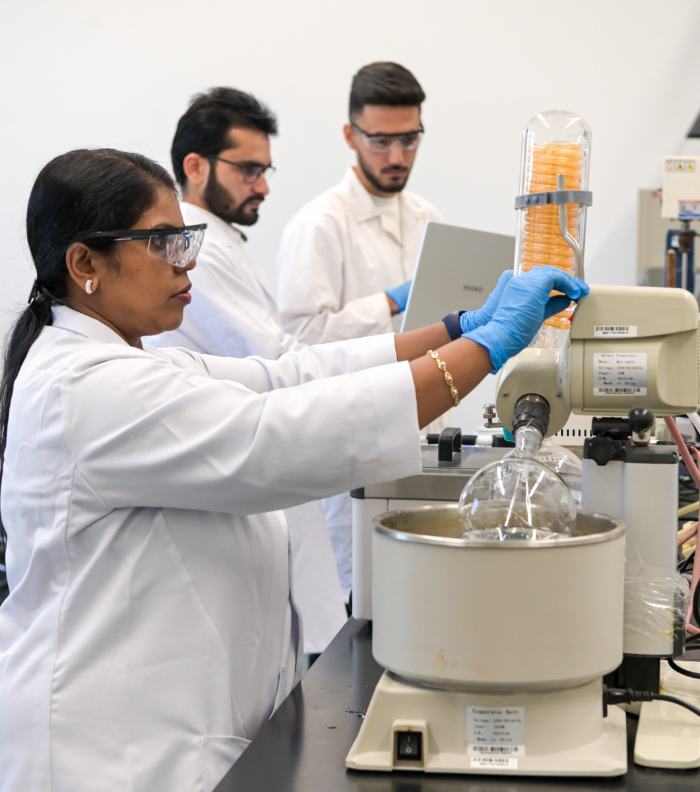As part of American University of Sharjah’s (AUS) ongoing focus on energy and sustainability, a collaborative research team at AUS is working on designing thermal energy storage systems that will assist in the transition to renewable energy.
“Due to environmental concerns, the world is shifting from fossil fuels towards more renewable energy sources, but unlike fossil fuels, which can be used to produce energy when required, solar and wind energy have variable supply, which makes energy storage a critical component in the transition towards clean energy. Recent improvements in battery technology have advanced energy storage capacity, but batteries also have their own issues in relation to safety and the relative scarcity of materials used in their production. This is why it is essential to use a mixture of other energy storage solutions to complement the use of batteries,” said Dr. Paul Nancarrow, Professor in Chemical and Biological Engineering and lead researcher.
The team’s focus is on ionic liquid technology, which are salts that can melt at room temperature and turn into liquid. Their wide range of applications are being studied in AUS labs, including thermal energy storage.
“There are theoretically millions of different ionic liquids that can be synthesized in the laboratory, each with different properties. However, lab synthesis is time consuming and costly. To overcome this problem, we were successful in developing several new data-driven predictive models to help us narrow the selection of optimal ionic liquid structures to synthesize and test and design new classes of ionic liquids to be used as energy storage systems,” Dr. Nancarrow said.
The work involves designing ionic liquids as phase change materials, which absorb and store energy when they melt at a particular temperature matched to the application, and release the energy again when the temperature drops and they cool and solidify. They can be incorporated into buildings, industrial facilities, electronic devices and clothing to help control temperature, store energy and reduce energy needs. For example, phase change materials that melt at room temperature can be incorporated into building walls to keep the building cool during hot days and warm during cool nights, maintaining a constant temperature and reducing the building’s heating and cooling energy requirements.
“The current systems have many problems that limit their applications including corrosion, loss of efficiency over time, loss by evaporation, degradation and large thermal expansion. What we are working on is designing ionic liquids with optimal properties for various applications to overcome these issues and provide an additional energy storage solution to reduce energy consumption and complement renewable energy production. This will help lead to a faster introduction of clean energy and reduce fossil fuel consumption on the global scale. Our next step in our research is to incorporate the optimized ionic liquid into solar energy systems and analyze the improvement in efficiency that can be achieved,” said Dr. Nancarrow.
The collaborative research involved AUS graduate and undergraduate students Samira Zeinab, Mohammad Tajiki and Mohammed Shahin and research associates Shehzad Liaqat, Sarika Regunadh and Dhruve Mital. It also involved professors Dr. Taleb Ibrahim and Dr. Nabil Abdel Jabbar from the Department of Chemical and Biological Engineering; and Dr. Mustafa Khamis, Professor in the Department of Biology, Chemistry and Environmental Sciences. It also involves collaboration with the Solar Energy Applications Group in Trinity College Dublin. The research work was carried out in the labs of the AUS College of Engineering (CEN), with partners at the Trinity College Dublin conducting tests on novel ionic liquids to improve the efficiency of solar energy systems.
With a reputation as one of the region’s most sustainable universities, AUS has made sustainability a main area of focus in its academic research and operations. It has been invited by the UAE Climate Envoy to COP28 to be a part of the COP28 University Taskforce, allowing representatives from AUS to inform key debates on climate change. AUS has also been ranked by the Association for the Advancement of Sustainability in Higher Education (AASHE) as one of the top five institutions worldwide for community engagement in sustainability, according to AASHE’s 2022 Sustainable Campus Index. In addition, AUS was the first university in the MENA region to achieve an AASHE STARS sustainability ranking.
The university’s chemical and biological engineering program occupies a unique position at the interface between molecular sciences and engineering, linking with the basic subjects of chemistry, mathematics, physics and biology. It offers unparalleled opportunities to design, develop and operate industrial processes that make great contributions to the technological infrastructure of modern society. For more information, visit www.aus.edu/cen/bsche.


COMMENTS